Win CENS ProFlex DX5 earplugs worth £1,149 – enter here
It’s not the classic time for pigeon roosting but …
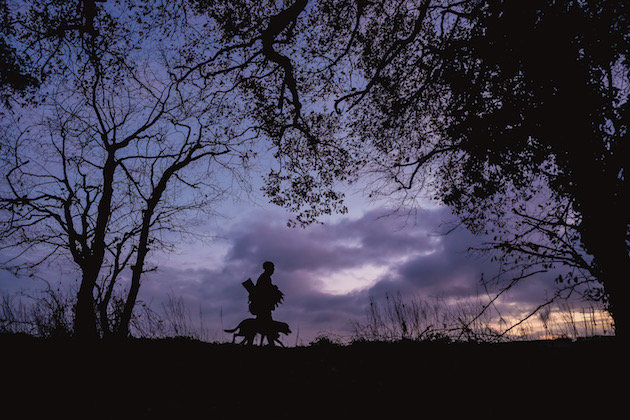 Tom packs up and heads out of the woods at last light with Woody
Tom packs up and heads out of the woods at last light with Woody
’Many of you reading this will be thinking, why is there a pigeon roosting article at this time of year? Has Shooting Times bucked the usual trend of pigeon shooting specials in February, the classic pigeon month when traditionally we can use all three methods of pigeon management — roosting, decoying and flighting?
The simple answer to that question is yes; this isn’t a normal year, as we are all very aware. However, the goalposts for pigeon have only been moved temporarily. A lot of our winter pigeon shooting isn’t really governed by pigeon damage over many farms and estates. Our pigeon shooting is governed by how much we will be disturbing the game that might be at large in hedgerow, spinney, copse, cover or woodland.
Any top keeper knows that respectful pigeon shooting before pheasants have been consistently shot doesn’t affect them if decoys are being employed. Once birds have heard the hustle and bustle of a day’s shooting, combined with eight gun salutes, they tend to become a bit more on edge, so obviously shooting the roosting woods is an absolute no-no from the off. Completely understandable.
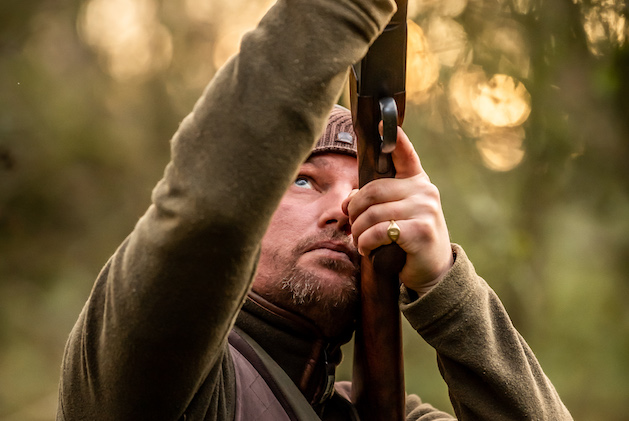
As the sun sets, a small flock swoops down into the trees
Prime month for pigeon roosting
The only reason February has become that traditional month for pigeon roosting is because of the above. February is a prime month for roosting but it certainly isn’t the only month. Shooting in fir woods starts from early November and mid-November for hard and mixed woods once the leaves are off the trees.
So why the sudden change of the norm? Due to the interloper COVID-19, some shoots are not shooting at all, having decided to rest the ground and develop habitat. This means that woods you couldn’t shoot until February are now in play. Many shoots have dramatically reduced days, so owners and keepers are more relaxed and due to the second lockdown, many shoots haven’t even flown a pheasant yet.
I’m always religiously checking the weather forecast and the long-range at the moment is frankly terrible. After a terrible night looking after my poorly young Labrador, Woody, I woke looking forward to a good afternoon flighting and roosting on a friend’s charming farm. Strong winds were predicted, which was perfect.
However, at 7.30am this was not the case, so I grabbed my phone frantically to recheck the forecast.
There will be rain in the morning, it informed me, as I watched water cascading down the windows. Afternoon dry, it said. This was good but the wind outlook had gone from gale force to a light breeze. I don’t understand how the forecasters can get it so wrong.
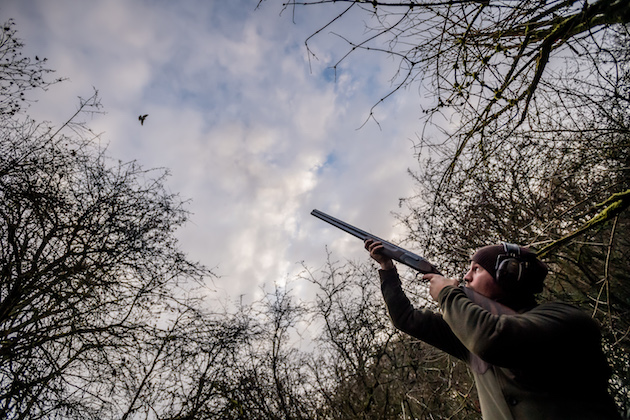
Birds continue to drift over Tom’s position in the roosting wood
Early finish
It was a miserable afternoon and would inevitably cause an earlier finish, so I always try to get out in the woods a bit earlier. I parked up in the yard and slipped and slid my way down to the wood along a field margin, noticing the incredible number of fallow slots. It was still spitting a bit but that would be OK.
The wood I was shooting is deceptively large, smack in the middle of undulating north Oxfordshire Cotswold ground. There are a few small firs at the heart of it but no real size; it’s mainly oak, ash and beech.
At some point this wood is going to get busy due to quite a large acreage of winter oilseed rape being grown on a distant bank, but there were a few birds roosting already.
Normally, I wouldn’t go roost shooting on such a still evening but this is a standalone wood that is a real draw to the local pigeon population and I’m the only one who shoots it, so it doesn’t get pressured too much. Plus it was lockdown two and I was so bored I was going anyway, regardless of conditions.
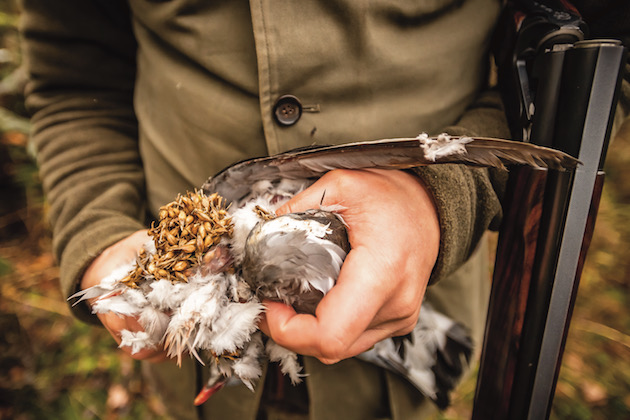
Tom checks the crop of the pigeon to see what it had been feeding on in local fields
Silhouette
I tucked myself in an opening with tall beech trees 40 yards back surrounded by smaller trees and a large ash next to me. I had a perfect 360-degree window to shoot in. You have to maximise your angles and have good visibility when roosting but make sure your background is good so that your silhouette blends in.
A few birds drifted over but they were monstrously high. You need a strong wind to bring the birds down and keep them moving . The wind also helps to mask the noise of your shooting. I couldn’t resist; I had to have a go.
A single, incredibly high pigeon sailed over and, despite two shots, continued on its journey. The same thing happened with the second, but I took a bit of time and watched the next couple, thinking about what they were doing on the wing.
They weren’t doing a lot; flying very true on the line and at an unpestered pace. As the next bird came over I focused hard, controlled the pick up and, with gentle gun speed, accelerated through the bird pulling the trigger. Absolutely stone dead at a good 55 to 60 yards.
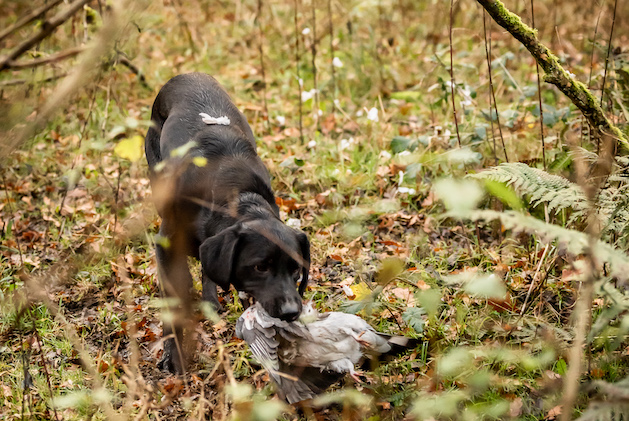
Woody retrieves the first bird of the day in style, having marked its fall after Tom pulled the trigger
Sometimes it takes a bit of patience and time simply to watch the birds to see what they are doing. I sent Woody for the retrieve. He had marked it well and, though he took a slightly diverted route on the way back, I was happy with his retrieve. I was feeling good, as birds continued to drift over between 40 and 60 yards.
After nine birds or so in, one of them with its landing gear down dropped into the ash tree 25 yards to my right. I took two shots but there was not a feather. That brought me back down to earth; even the dog looked at me in disgust.
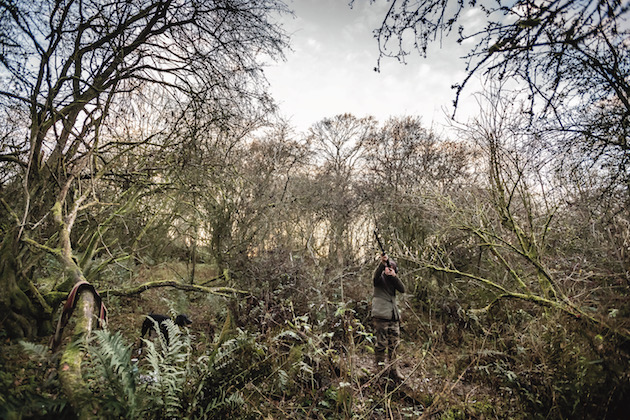
Tom shoots more pigeons as dusk descends
As I approached the last half an hour birds were coming in looking to get into the trees. A small flock descended from a great height and with quite some speed and agility whiffled through the trees. Pigeon really are incredible flyers and I was unable to even attempt a shot because I became completely flustered as to which bird to engage.
The evening drew to a close and, with the telltale sign of a cock pheasant going to roost and the jackdaws making a noise in the distance, it was time to pull stumps. It had been a good session that ended with a pleasing 19 in the bag.
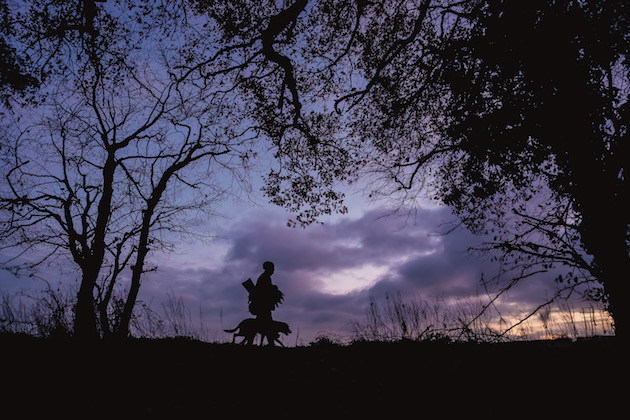
After a satisfactory session Tom packs up and heads home at last light with Woody
As I walked back to the farmyard I bumped into Terry, the farmer and a true countryman. He came over for his two brace of birds as he always does and we stood back, looking at the wood as at least 2,000 jackdaws in full cry descended into it. On a nice evening, it’s quite a spectacle and an amazing way to finish the outing.
Related Articles
Get the latest news delivered direct to your door
Subscribe to Shooting Times & Country
Discover the ultimate companion for field sports enthusiasts with Shooting Times & Country Magazine, the UK’s leading weekly publication that has been at the forefront of shooting culture since 1882. Subscribers gain access to expert tips, comprehensive gear reviews, seasonal advice and a vibrant community of like-minded shooters.
Save on shop price when you subscribe with weekly issues featuring in-depth articles on gundog training, exclusive member offers and access to the digital back issue library. A Shooting Times & Country subscription is more than a magazine, don’t just read about the countryside; immerse yourself in its most authoritative and engaging publication.







